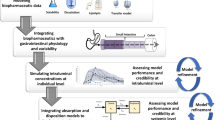Abstract
The assessment of drug interactions for a simple turnover system when the basic pharmacodynamic response is governed by indirect mechanisms was explored. This report describes a diverse array of possible in vivo pharmacodynamic effects from a combination of two drugs acting by similar or different indirect mechanisms. Various conditions of pharmacodynamic drug combinations were explored mathematically and by simulation: (a) interactions of two drugs acting simultaneously either on the production (k in ) or on the dissipation (k out ) processes controlling the in vivo response by competitive (four cases) or non-competitive interaction (six cases); and (b) combinations of two drugs acting on separate k in and k out processes simultaneously (four cases). A range of different combinations of drug doses was used. Plasma concentration time profiles were generated according to monoexponential disposition. Pharmacodynamic response profiles were simulated using the above conditions and characterized by descriptors such as Area Between Effect (and Baseline) Curve (ABEC) values. The interaction of agents by competitive mechanisms produced net responses that were additive in nature. Response profiles for non-competitive interactions on the same process were both antagonistic (for two drugs with effects that oppose each other) and synergistic (for two drugs that produce the same response). On the other hand, response signatures for agents acting non-competitively on the production and dissipation factors by opposing mechanisms (e.g. inhibiting k in plus stimulating k out ) showed dramatic changes in net effects and produced apparent drug synergy. Net indirect response profiles for joint use of two or more drugs measured by ABEC values may look “additive”, “antagonistic”, or “synergistic” depending on doses, their intrinsic potencies, the nature of interaction (competitive or non-competitive) as well as their mechanisms of action. These models may help explain changes in pharmacologic responses to two agents in a more rational and mechanistic fashion than older empirical methods.
Similar content being viewed by others
Author information
Authors and Affiliations
Corresponding author
Rights and permissions
About this article
Cite this article
Earp, J., Krzyzanski, W., Chakraborty, A. et al. Assessment of Drug Interactions Relevant to Pharmacodynamic Indirect Response Models. J Pharmacokinet Pharmacodyn 31, 345–380 (2004). https://doi.org/10.1007/s10928-004-8319-4
Received:
Accepted:
Issue Date:
DOI: https://doi.org/10.1007/s10928-004-8319-4




